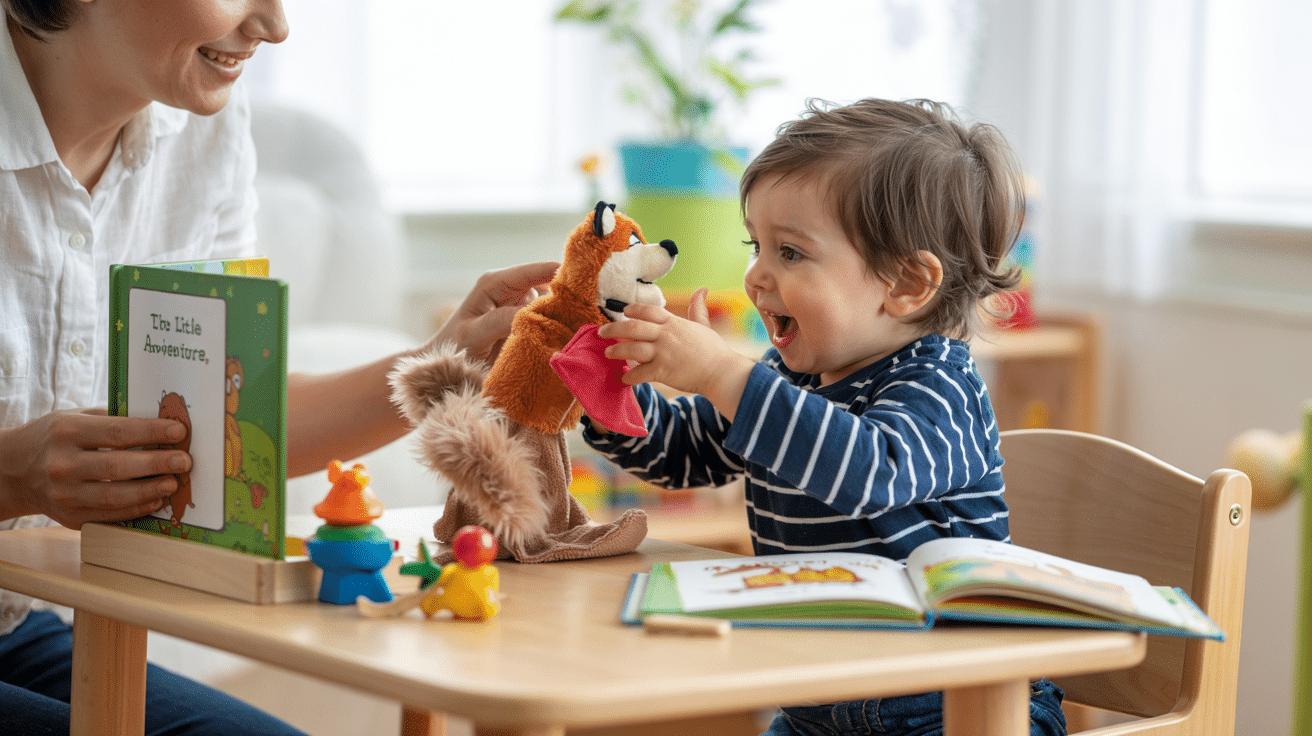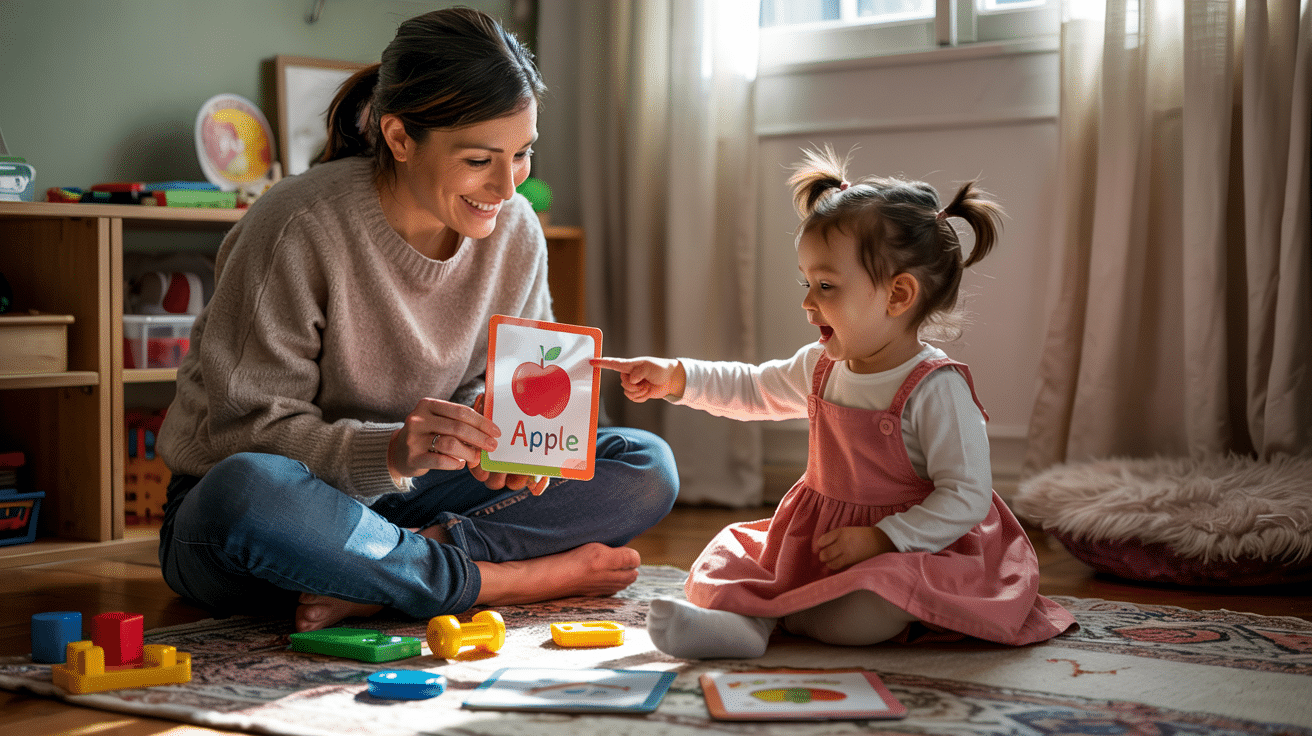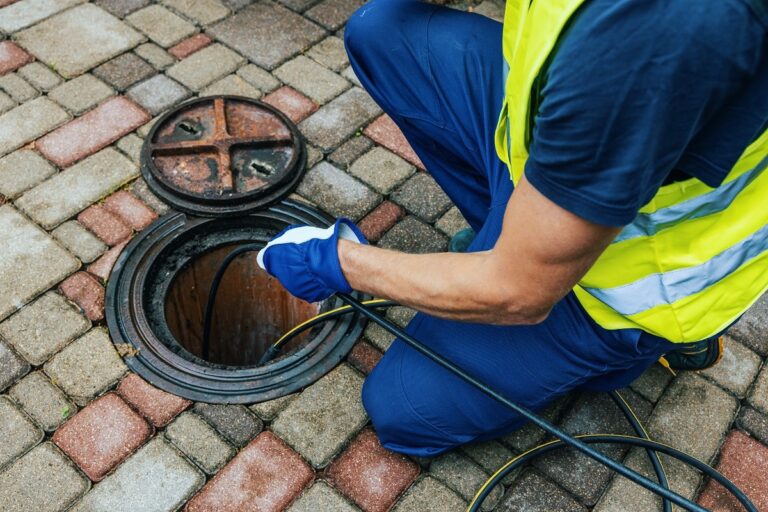Is your toddler struggling with speech development? You’re not alone.
Many parents face similar challenges, and the good news is that there’s a lot that can be done right at home. With the right tips and techniques, boosting your toddler’s speech therapy can become a fun and rewarding part of daily life.
In this blog, you’ll find simple yet effective strategies that encourage language growth, enhance communication skills, and keep your little one engaged. Whether you’re looking for interactive games, everyday activities, or expert-approved tips, these ideas are designed to fit seamlessly into your routine.
Ready to help your toddler take those next big steps?
Let’s have a look at these practical tips that can make speech therapy for toddlers at home beneficial and joyous.
Speech and Language Milestones for Toddlers

Understanding typical speech and language milestones helps parents know when to start speech therapy for toddlers at home and establish realistic expectations for their child’s development.
By 12 months, many toddlers begin to say their first words, like “mama” or “dada.” By 18 months, a child might have a vocabulary of 10 to 20 words. Around 2 years old, toddlers often begin combining two words, like “want cookie.” By 3 years, they typically use simple sentences and understand basic grammar.
While milestones can vary, it’s important to recognize when a child may be falling behind or showing signs of speech delay, as early intervention can be highly beneficial.
Here’s a table outlining some key speech and language milestones for toddlers:
| Age | Milestones |
|---|---|
| 12 months | First words, like “mama” or “dada” |
| 18 months | Vocabulary of 10-20 words |
| 2 years | Combining two words into short phrases |
| 3 years | Using simple sentences, understanding basic grammar |
Remember, every child develops at their own pace, but staying mindful of these milestones can help ensure your toddler’s speech progress stays on track.
How to Implement Speech Therapy for Toddlers at Home

Implementing speech therapy for toddlers at home doesn’t require special training or expensive equipment; just your time, attention, and a commitment to consistent practice.
Interactive Games for Toddler Speech Therapy
1. Sound Safari
A hunt game where your child finds objects that start with target sounds.
- Items needed: Household items, pictures, or toys
- Instructions: Hide items around a room. Name a sound and ask your child to find things that start with it. Praise each find with clear pronunciation.
2. Mirror Talk
This face-to-face game helps your child see how mouth movements form words.
- Items needed: A small mirror
- Instructions: Sit with your child and the mirror. Make funny faces and sounds together. Let your child copy your mouth movements and sounds.
3. Puppet Chats
Puppets can make talking practice feel like play rather than work.
- Items needed: Any stuffed toy or sock puppet
- Instructions: Give the puppet a voice and have it talk to your child. Ask questions and wait for answers. The puppet can make mistakes for your child to fix.
4. Blowing Games
These fun activities build the mouth muscles needed for speech.
- Items needed: Bubbles, feathers, cotton balls
- Instructions: Show your child how to blow bubbles, move feathers through the air, or race cotton balls across a table by blowing them.
5. Silly Songs
Music makes word practice fun and builds memory for language patterns.
- Items needed: None, or simple instruments if you have them
- Instructions: Sing songs with actions and ask your child to join in. Make up silly verses with their name or favorite things.
6. Story Basket
This game builds vocabulary and sentence skills through objects.
- Items needed: Small basket, toys, or household items
- Instructions: Put 5-6 items in a basket. Pull them out one by one, naming each. Then, ask your child to tell a story using the items.
7. Phone Friend
Pretend calls teach turn-taking in conversation.
- Items needed: Toy phone or old real phone
- Instructions: Pretend to call your child’s favorite character or family member. Model simple conversations and let your child respond.
Everyday Activities for Effective Home Speech Therapy
8. Bath Time Bubbles
Turn bath time into a speech learning moment with water play and new words.
- Items needed: Bath toys, plastic cups, bubbles
- Instructions: Name each toy as you play. Use action words like “pour,” “splash,” and “float.” Count bubbles together. Ask your child to tell you what each toy does in water.
9. Laundry Day Helper
Sorting clothes teaches colors, sizes, and descriptive words.
- Items needed: Clean laundry pile
- Instructions: Ask your child to find items (“Where is daddy’s blue shirt?”). Sort by colors or types. Use words like “big/small” and “soft/rough.” Have them repeat simple phrases as they hand you items.
10. Grocery Store Detective
Shopping trips become word-finding missions with this activity.
- Items needed: Shopping list, grocery store
- Instructions: Ask your child to help find items. Name foods as you put them in the cart. Talk about colors, shapes, and sizes. Let them request items they want to add.
11. Cooking Helper
Kitchen time offers chances to learn food words and follow steps.
- Items needed: Simple recipe, safe kitchen tools
- Instructions: Let your child help with safe tasks. Name ingredients and tools. Use action words: “stir,” “pour,” “mix.” Count items together. Talk about hot/cold, sweet/sour as you taste.
12. Plant Care Partner
Growing plants teaches patience along with new vocabulary.
- Items needed: Small plants or seeds, a watering can
- Instructions: Talk about what plants need to grow. Use words like “water,” “sun,” “dirt,” and “grow.” Ask your child to tell you when plants need water. Name the plant parts they can see.
Expert-Approved Tips to Improve Speech for Toddlers
13. Focus on Communication, Not Perfection
Encourage any attempt at communication rather than constantly correcting pronunciation.
- Why it works: Children learn language through positive feedback loops
- How to implement: Respond to your child’s meaning, not their mistakes. If they say “wa-wa” for water, say, “Yes, here’s your water,” with the correct pronunciation.
14. Create a Language-Rich Home
Surround your child with words, books, and talking throughout daily routines.
- Why it works: Language exposure directly connects to vocabulary growth
- How to implement: Narrate what you’re doing, read books daily, and talk about what you see. Label objects in your home and discuss them often.
15. Follow Your Child’s Lead
Pay attention to what interests your child and use those moments for speech practice.
- Why it works: Children learn better when engaged with topics they enjoy
- How to implement: Notice what toys or activities grab their attention, then join in with relevant words and phrases about that interest.
16. Use Pausing and Waiting
Give your child time to process language and respond.
- Why it works: Processing time is essential for language development
- How to implement: Ask a question, then silently count to 10 before helping. This shows you expect a response and gives them time to form one.
17. Keep it Simple
Match your language level to just above your child’s current abilities.
- Why it works: Children learn best when new material builds on what they know
- How to implement: If your child uses one-word phrases, use two-word phrases. Progress naturally as their skills grow.
By implementing regular speech therapy for toddlers at home through these simple activities, you can make a significant difference in your toddler’s communication and language development.
Benefits of Conducting Speech Therapy for Toddlers at Home

Home speech therapy offers numerous advantages that complement professional services and boost your child’s progress.
- Comfort and Familiarity: Children often feel more at ease in their home environment. This comfort can reduce anxiety and resistance to speech exercises. When children feel safe, they’re more willing to try new sounds and practice difficult words without fear of judgment.
- Consistent Practice: Daily home practice reinforces skills learned in formal therapy sessions. Short, frequent practice sessions throughout the day help build neural pathways more effectively than occasional long sessions. This steady practice schedule leads to progress faster and better retention of new speech skills.
- Real-Life Context: Home therapy happens in settings where language is actually used. This makes learning more meaningful and practical for your child. They can immediately apply new words and sounds to objects and situations they encounter every day.
- Parent-Child Bond Strengthening: Working together on speech activities creates special moments of connection. These positive interactions build trust and improve your understanding of your child’s communication style. The emotional support you provide during practice becomes as valuable as the exercises themselves.
- Cost-Effective Approach: Professional speech therapy can be expensive and may have limited availability. Home practice extends the benefits of professional sessions without additional cost. You can make use of everyday items and moments rather than purchasing special equipment.
By incorporating speech therapy for toddlers at home, you create countless opportunities for growth while building your child’s confidence in a loving environment.
Signs to Seek Professional Help for Your Toddler’s Speech

While speech therapy for toddlers at home can be highly effective, certain signs suggest your child might benefit from professional evaluation by a speech-language pathologist. The following speech delays might suggest signs of benefiting from professional care:
- Your 18-month-old uses fewer than 20 words or doesn’t use words to communicate needs.
- By age 2, your child may not be able to combine two words or may have difficult for family members to understand.
- Your toddler seems to understand much less than they should for their age group.
- You notice your child struggling to move their tongue or lips when trying to speak.
- Your toddler shows frustration when trying to communicate or has stopped trying to talk altogether.
If you notice these signs, discuss your concerns with your pediatrician, who can provide appropriate referrals for assessment and intervention.
Wrapping It Up
Supporting the speech therapy for toddlers at home is a path that combines patience, play, and purposeful practice.
Throughout this guide, we’ve looked at milestones that help you track progress, practical at-home therapy techniques, significant benefits of consistent practice, and warning signs that indicate professional help might be needed.
Remember that each child develops at their own pace. The goal isn’t perfection but progress. Even small improvements deserve celebration as your child builds communication skills that will serve them throughout life.
What’s your next step?
Pick one simple activity from our suggestions and try it today. Start with just five minutes and build from there. If you have concerns about your child’s speech development, don’t hesitate to speak with your pediatrician.
What speech activities have worked best for your toddler? Share your experiences in the comments below!















